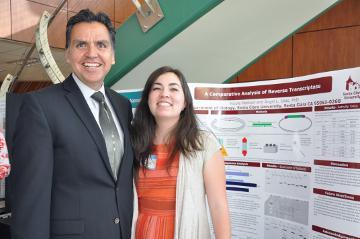
A Comparative Analysis of Reverse Transcriptase
Nicole Mattson
Faculty Mentor: Ángel Islas
Reverse transcriptase (RT) is an enzyme that uses RNA as a template to transcribe DNA, an activity found in retroviruses such as the Human Immunodeficiency Virus (HIV). HIV has its two identical copies of single-stranded RNA converted by RT to double stranded DNA that then gets incorporated into the host's DNA. The process of synthesizing first one strand of DNA from two RNA strands is called template jumping. The exact mechanism of template jumping is not fully understood, so we must look to other RTs to model template jumping to see how it has changed or been preserved through evolution. Our research will work to find conserved domains within various RTs or differences that can be accounted for in their ability to template jump. Three different types of RT will be compared: the HIV RT which functions as a heterodimer of p51 and p66, the Avian Myeloblastosis Virus which also functions as a heterodimer but has an alpha and beta subunit, and the Mouse Mammary Tumor Virus which functions as a monomer. In order to compare all of the various RTs, we will clone each subunit and determine template jumping activities of each subunit to isolate the functional similarities and differences between each retrovirus’ RT. With a greater understanding of this process, better inhibitors can be designed to target retroviruses. In addition, if this process is inhibited, it will be a generic treatment for all retroviral diseases.